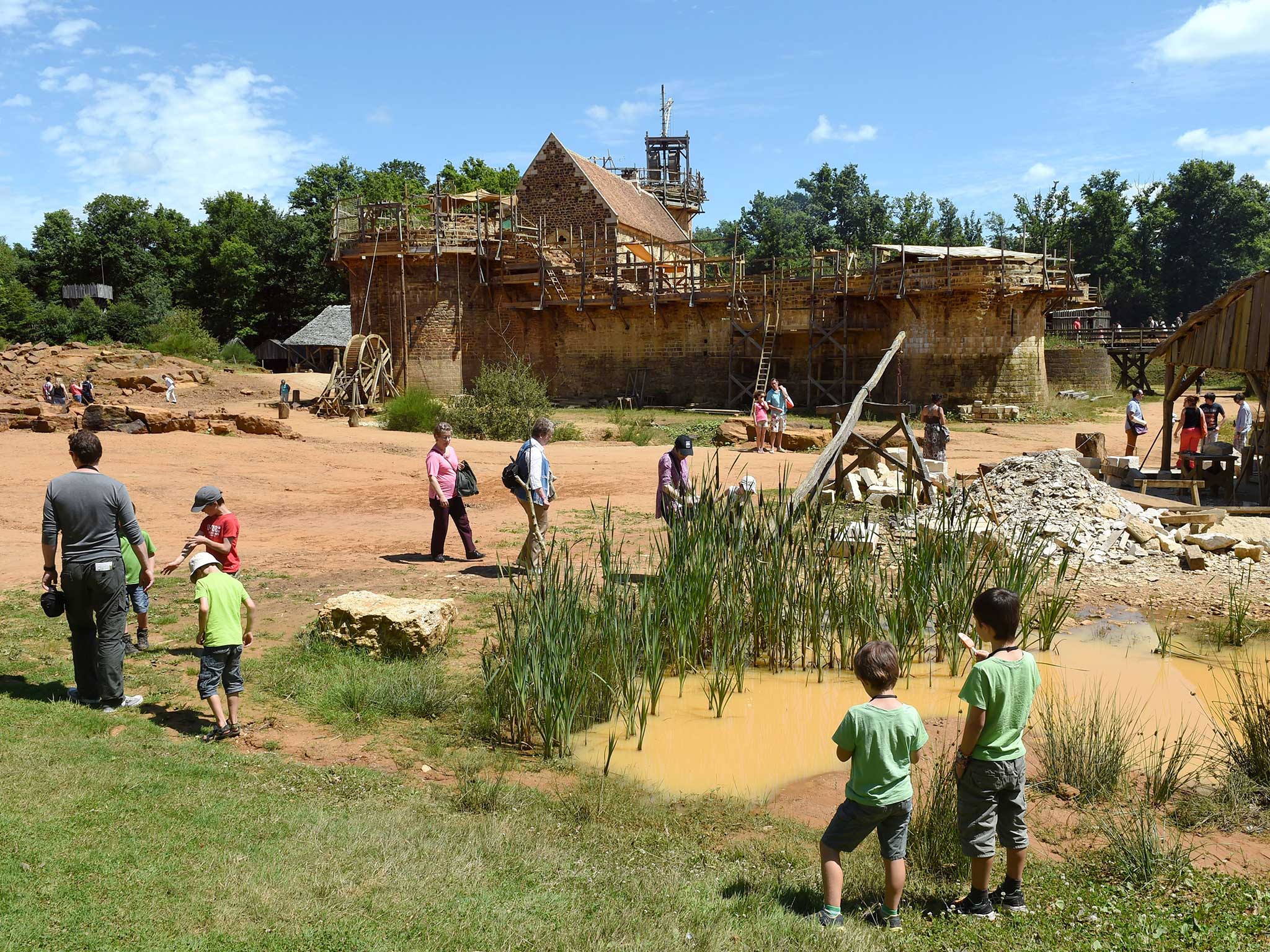It’s now 1245, and the walls of Guédelon are rising
In Burgundy, John Lichfield watches the first truly medieval castle in 500 years take shape

The last time I visited Guédelon was in 1241. That was four years ago. How time flies.
Since then, the early medieval castle under construction in the forests of northern Burgundy has risen by many “arms’ lengths” and by many “palms” and “thumbs”. Metres and centimetres do not exist here. Nor do bulldozers, drills, spirit-levels, concrete-mixers, breeze blocks, pneumatic drills or load-bearing steel joists.
It is now 1245. Two of Guédelon’s six towers are approaching completion. The castle’s main defensive walls are rising. The beam roof on the main range of buildings is fully tiled. One chamber has been decorated to 13th-century tastes. The kitchen is finished and produces delicious bread, using flour ground in the world’s only working 13th-century water mill (built last year).
In the irritating, muddled world of 2014 beyond the Guédelon car-park, François Hollande has replaced Nicolas Sarkozy as President of France. In the world of Guédelon, good King Louis IX is still on the throne. The son of Bad King John, “average” King Henry III, is on the throne of England.
There is a peaceful and prosperous lull between two crusades. The Black Death and the Hundred Years’ War are a century away.
For 15 years, almost since the beginning of the project, The Independent has been following the progress of Guédelon, the first medieval castle to be built with entirely medieval methods for 500 years, and the first of its kind to be built for nearly eight centuries.
This autumn, the noble and fascinating legend of Guédelon will reach a new audience through the balladeers and troubadours of the 21st century – TV documentary-makers. The award-winning British team who made Victorian Farm completes filming next week on a five-part documentary on Guédelon. The series will air on BBC2 in November.
With 300,000 visitors a year, Guédelon is self-funding, with no need for 21st-century grants or subsidies. Even so, it deserves the wider notoriety that television will bring.
The Château de Guédelon is not a hey-nonny-no-medieval theme-park. It is an exercise in experimental archeology, or archaeology in reverse: discovery by building up, rather than digging down.
Regarded by many at first as an eccentric whim of its founder, Michel Guyot, 66, a local entrepreneur, Guédelon has helped archeologists and historians solve many puzzles. How did our distant ancestors – without benefit of computers or health-and -safety rules – construct such extraordinary buildings?
Maryline Martin, director and driving force of the project, said: “At the start, we needed the archeologists. Now, they turn to us to try to answer their questions. Most importantly, what we have learned is that a building like this cannot be constructed to a pre-conceived, academic plan. Many of our problems have been solved by the practical experience of the masons or quarrymen or carpenters as they worked on the building.
“I think our greatest achievement is to have recreated the human adventure of castle-building; the team-work, the energy, the dynamism.”
To prevent Guédelon becoming a medieval pastiche, Ms Martin gave it a fictitious owner: Seigneur Guilbert, a middling lord, with youngish children. She also gave it a narrative: a new-build, small residential castle to a common late 12th- and early 13th-century design, commissioned in 1228 (actually 1997). No complete early 13th-century residential castle survives. The design of Guédelon is based on fragments and pictures.
There are 70 full-time employees, who work in medieval clothes but not medieval shoes, for safety reasons. Almost all the materials, and many of the tools, are quarried, gathered or made on site: the stones, the mortar, the ropes, the nails, the saws, the timber, the wooden lifting-engines.
A medieval village has sprung up around the castle, with a forge, a rope-maker, a tile-maker, a wood carver, a mason’s yard, a pigment-maker and a weaver.
The project is a compromise between 13th-century methods and 21st-century habits, laws and regulations. Can workers have cigarettes, 300 years before Sir Walter Raleigh? No, but visitors can. Can a medieval labourer wear spectacles? Yes. Do they wear hard-hats? Sometimes.
Sarah Preston, 41, from Bath, began work at the castle as an English-language guide and is now press officer. Ms Martin insists that Sarah is, in fact, a paid and much-valued “hostage”. Ms Preston said: “I don’t think this project could have happened in Britain. [Health and safety] wouldn’t have allowed it. Here, the local safety committee has been so happy to work closely with us. There have been small incidents ... but, without wanting to tempt fate, no serious injuries.”
As the castle moves slowly towards its estimated completion date of 1254 (or 2023 if you insist) a great, existential problem must be confronted. By trial and error, Guédelon masons discovered an effective form of mortar, a mix of quicklime and rough sand matching almost exactly mortar from 13th-century ruins nearby.
The lime in the mortar began to flow from the masonry joints, slightly disfiguring the stonework. Archaeologists were delighted. It solved a conundrum. We think of medieval buildings – from castles to cathedrals – as having exposed stonework. In fact, they were plastered over and painted white or in bright colours.
Thanks to Guédelon, historians and archeologists now think that the rendering was needed to cover up the streaks of lime from the mortar.
What should happen to the beautiful stonework at Guédelon? Plastered and painted white, it will be “authentic”. But it may look, to us, like a giant pebble-dash bungalow.
“We have yet to make that decision,” Ms Martin said. “Personally, I would like to see Guédelon plastered and painted in bright colours. However, I think that we will leave some of the stonework uncovered. Just to prove that it is not a fake ….”
Join our commenting forum
Join thought-provoking conversations, follow other Independent readers and see their replies
Comments
Bookmark popover
Removed from bookmarks